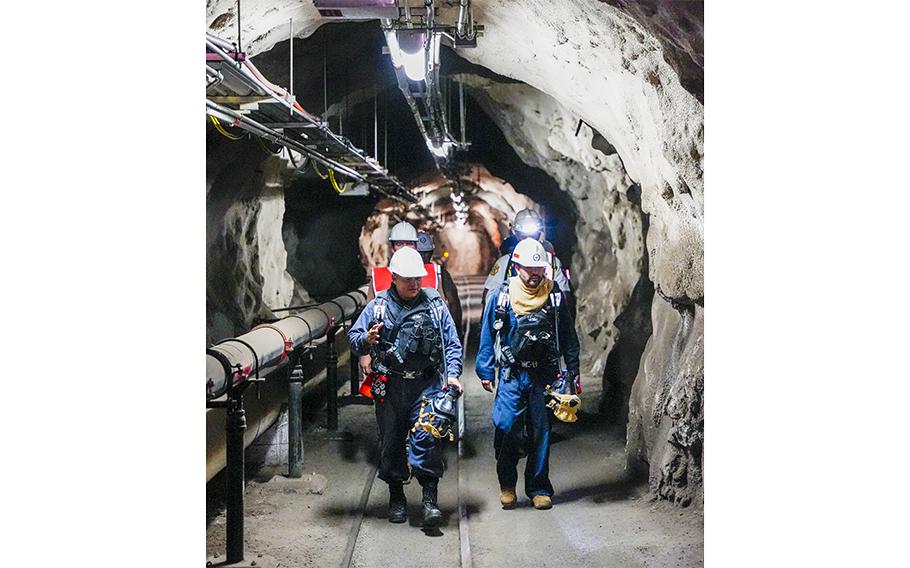
Joint Task Force-Red Hill roving security and fire watch team members conduct a roving patrol during a final exercise prior to repacking at the Red Hill Bulk Fuel Storage Facility, Halawa, Hawaii, on Aug. 17, 2023. (Nicholas Brown/U.S. Air Force)
(Tribune News Service) — Joint Task Force Red Hill, the organization the Pentagon set up to drain the massive fuel tanks at the Navy's underground Red Hill Bulk Fuel Storage Facility, announced Thursday that it has completed training for its roving security and fire watch team.
The team, made up mostly of local Hawaii National Guard members and Army reservists, will conduct 24-hour surveillance of the site, walking through the underground facility in shifts to inspect the fuel lines that connect Red Hill to Joint Base Pearl Harbor-Hickam looking for any potential leaks, fires or other hazards.
"Roving security and fire watch is essential to improve safety during repacking and defueling operations, and part of JTF-RH's layered approach to early hazard detection and fire suppression at the RHBFSF," Joint Task Force Red Hill's deputy commander Brig. Gen. Michelle Link said in a media release. "These teams allow for a boot on ground approach, which will significantly mitigate the risk of an incident occurring."
Among the aspects of training the troops received was how to execute an initial and rapid response to a fire. They received basic, advanced, and industrial firefighting training to combat different types of fires in compact spaces. The trainees also received instruction in emergency medical services such as CPR and defibrillator use. But ultimately, their main job is to know when and how to notify the Federal Fire Department and other authorities to respond in the event of a fire.
The potential for a fuel fire is a major concern as JTF Red Hill prepares to drain the massive tanks, which are currently storing 104 million gallons of fuel over a critical aquifer that most of Oahu relies on for water.
Red Hill's troubled fire suppression system played a central role in the 2021 fuel leaks that contaminated the Navy's Oahu water system, which serves 93,000 people, including military families and civilians renting homes in former military housing areas like Kapilina Beach Homes.
A Navy investigation found that fuel from a May 6, 2021, spill descended into a lower tunnel and ended up being pumped into a pipeline that's part of the facility's fire suppression system. Months later, on Nov. 20, 2021, a worker accidentally hit and ruptured the pipeline, spilling thousands of gallons of fuel and water that flowed into a drain used to release rainfall infiltration back into the environment, where it contaminated Red Hill water well and then the Navy's entire water system.
After years of insisting the facility was safe, over the objections of local officials warning that the facility was a "ticking time bomb" that threatened Honolulu's water, the
Pentagon announced in March 2022 that it would shut down the facility and formed JTF Red Hill.
Documents released by the military since then show that despite years of insisting it was safe, the Red Hill facility had fallen into a state of deep disrepair and would require extensive maintenance and upgrades to safely remove the fuel inside. JTF Red Hill has been doing those repairs and is prepairing for defueling, which is set to begin in October.
Built underground during World War II to hide it from the Japanese Imperial Navy, the unique architecture that made the facility nearly impossible for enemy forces to locate or attack also posed unique challenges for operations and maintenance. Well before the 2021 fuel spills, internal documents raised concerns about safety at Red Hill, particularly fire risks.
A March 2014 Pentagon budget request for $50 million in improvements to Red Hill's fire suppression system noted that analysts had concluded "the existing underground fueling
facility at Red Hill has inadequate fire protection infrastructure and communication system" and that "fueling operations in the underground complex create high potential for fire incident."
The request further asserted that "fires involving fuel are extremely difficult to extinguish. This is even more so in the underground tunnels of the Red Hill tank farm because of the confined spaces. Also the ventilation within the tunnel as well as the remote location and inadequate fire protection infrastructure external to the tunnel make this a high risk operation."
(c)2023 The Honolulu Star-Advertiser
Visit The Honolulu Star-Advertiser
Distributed by Tribune Content Agency, LLC.